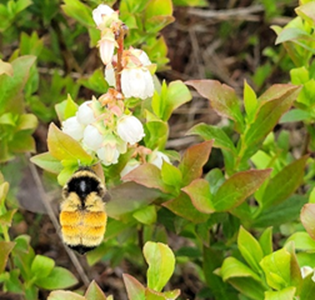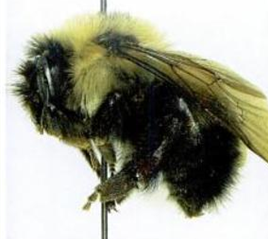In Atlantic Canada, commercially managed bees, such as honey bees, are the main insects used for pollination, but native bees also play an important role in wild blueberry pollination. Some of the native pollinators involved in pollination include bumble bees, andrenid bees, halictid bees and mason bees(1). Bumble bees (genus Bombus) use floral sonication or buzz pollination while foraging, which involves vibrating the flower to allow pollen to be released from the anthers. Wild blueberries have coevolved with bumble bees to allow the release of pollen using this method(2). Given the symbiotic relationship bumble bees have with wild blueberries, and their suitability for Atlantic Canada’s climate, bumble bees are very efficient pollinators in the Maritimes. Read this week’s blog to learn about the multiple species of wild bumble bees that contribute to blueberry pollination in the Maritimes, and key features to identify them.
Get to Know Your Bumble Bees
Eastern
Canada has a large diversity of bumble bees, with over 18 known species found
in our region, and over 40 species found throughout Canada. That being said,
some are found foraging around blueberry fields in Atlantic Canada more often
than others, and those are the species being highlighted with the information
provided.
Bombus
impatiens, the common
eastern bumble bee, is the most encountered bumble bee across eastern Canada.
The species is highly adaptable and can live in country, suburbs, and urban
cities3. Their adaptability makes them a great pollinator species,
leading to an increase in their commercial use. When identifying the common
eastern bumble bee, queens have bigger bodies measuring 17–23 mm. Workers have
bodies that are 8.5–16 mm, and males have bodies that are 12–18 mm(3).
Queens and workers are both black with a yellow thorax and yellow first
abdominal segment. Drones slightly differ in their coloring, where they have a
yellow face and head(4).
Bombus
ternarius, commonly
known as the orange-belted bumble bee or tricolored bumblebee, is a yellow,
orange, and black bumble bee. The species is also common throughout eastern Canada(5).
Bombus ternarius is a small, fairly slender bumble bee. The
queen is 17–19 mm long. The workers are 8–13 mm, and drones are 9.5–13 mm in
length. The queens and the workers have black heads, with a few pale-yellow
hairs. The anterior and posterior thorax and the first and forth abdominal
segments are yellow. Abdominal segments 2 and 3 are orange, and the terminal
segments are black(6,7). The drone has a yellow head with a few
black hairs(6,7).
Bombus
bimaculatus, the
two-spotted bumble bee, can be found throughout Atlantic Canada. The bee's
common name comes from the two yellow spots on its abdomen(8).
Queens and workers have a black face with a triangular patch of yellow hairs on
the vertex. Their thorax is yellow except for a shining area on the disc that
is bordered by black hairs(9).
Drone faces have intermixed black and yellow hairs(9).
Bombus
vagans, the
half-black bumble bee, is a small bumblebee with a wide distribution in North America(10),
and present throughout eastern Canada. The head, thorax and first two segments
of the abdomen are yellow while the rest of the abdomen is black, hence the
name “half-black”(11). The face has a mixture of yellow and black
hairs, and the thorax is covered in shaggy yellow hair except for a smooth
central portion which is bare and shiny(11).
Bombus
rufocinctus, the
red-belted bumble bee, is another species found in Atlantic Canada. The queen
is 16–18 mm long. She is black with scattered gray and yellowish hairs on the
head. Her abdomen has many bright yellow hairs and areas of reddish hairs(12).
The worker is 11–12 mm long. She is similar to the queen, but she may have
longer hair. The male is 12–13 mm long. He is mostly black with more yellow on
the head and abdomen(12).
A final
species to mention is Bombus terricola, the yellow-banded bumblebee, which
is native to southern Canada. It was at one time a common species but has
declined in numbers since the late 1990s(13). The Xerces Society for
Insect Conservation has placed Bombus terricola on their "Red
List" of endangered bees. The yellow-banded bumblebee is black and yellow
and has a characteristic fringe of short yellow-brown hairs on its fifth
abdominal segment(13). The queen is about 18 mm long. The worker is
similar in appearance to the queen but smaller at a length of 9–14 mm(13).
The male is intermediate in size, being 13–17 mm long(13).
It is important to remember the role native pollinators have
when it comes to wild blueberry pollination. The background pollination
provided by bumble bees and other native pollinators is not insignificant, so,
as an industry, there are important steps and considerations for protecting
these native pollinators that, in turn, will benefit the industry.
References
- Sheffield, C.S., Kevan, P.G. and Smith, R.F., 2003. Bee species of Nova Scotia, Canada, with new records and notes on bionomics and floral relations (Hymenoptera: Apoidea). Journal of the Kansas Entomological Society, pp.357-384.
- De Luca, P.A. and Vallejo-Marín, M., 2013. What's the ‘buzz’ about? The ecology and evolutionary significance of buzz-pollination. Current opinion in plant biology, 16(4), pp.429-435.
- Williams, P.H., Thorp, R.W., Richardson, L.L. and Colla, S.R., 2014. Bumble bees of North America: an identification guide (Vol. 89). Princeton University Press.
- Plath, O.E., 1934. Bumblebees and their ways. Bumblebees and their Ways.
- Eaton, E.R. and Kaufman, K., 2007. Kaufman field guide to insects of North America. Houghton Mifflin Harcourt.
- Richards, O.W., 1946, September. Observations on Bombus agrorum (Fabricius)(Hymen., Bomhidae). In Proceedings of the Royal Entomological Society of London. Series A, General Entomology (Vol. 21, No. 7‐9, pp. 66-71). Oxford, UK: Blackwell Publishing Ltd.
- Cumber, R.A., 1949. The biology of humble-bees, with special reference to the production of the worker caste. The Royal Entomological Society of London.
- Devore, B. 2009. Pollinators. Department of Natural Resources: 12.
- Medler, J.T. and Carney, D.W., 1963. Bumblebees of Wisconsin.
- Hatfield, R., Colla, S., Jepsen, S., Richardson, L.L., Thorp, R.W. and Jordan, S.F., 2014. IUCN Assessments for North American Bombus spp. for the North American IUCN Bumble Bee Specialist Group. The Xerces Society for Invertebrate Conservation. Available online: https://xerces. org/sites/default/files/publications/14-065. pdf (accessed on 18 August 2020).
- Colla, S., Richardson, L. and Williams, P., 2011. Bumble bees of the eastern United States. USDA Pollinator Partnership.
- Owen, R.E. and Plowright, R.C., 1988. Inheritance of metasomal pile colour variation in the bumble bee Bombus rufocinctus Cresson (Hymenoptera: Apidae). Canadian journal of zoology, 66(5), pp.1172-1178.
- Hatfield, R.G. and Jepsen, S.A.R.I.N.A., 2021. A conservation conundrum: protecting bumble bees under the California Endangered Species Act. California Fish Wildlife J, 107, pp.98-106.
Connecting with ATTTA Specialists
If you’d like to connect with ATTTA specialists or learn more about our program, you can:
visit our website at https://www.perennia.ca/portfolio-items/honey-bees/
Email abyers@perennia.ca






